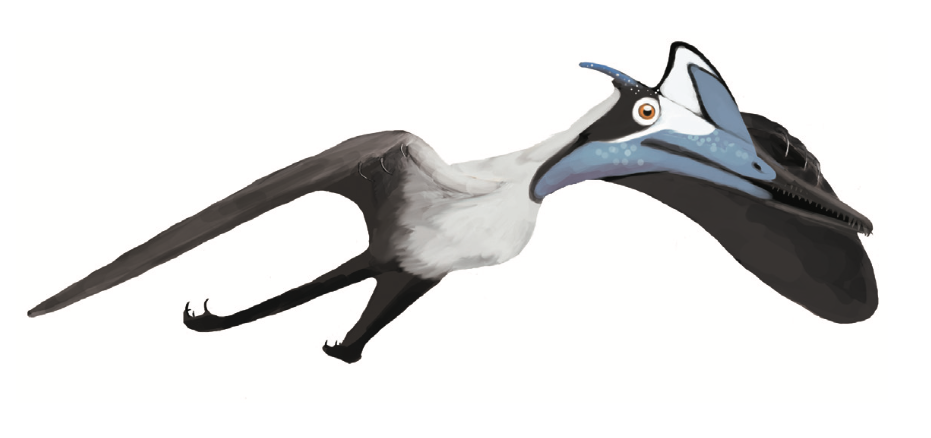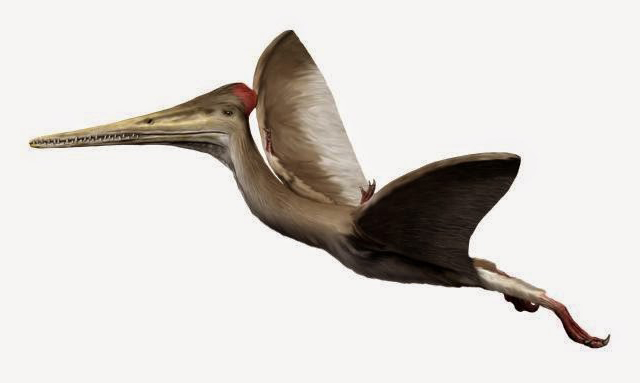|
Germanodactylidae
Germanodactylidae is a controversial group of pterosaurs within the suborder Pterodactyloidea. It was first named by Yang Zhongjian in 1964, and given a formal phylogenetic definition in 2014 by Brian Andres, James Clark, and Xu Xing. They defined it as the least inclusive clade containing ''Germanodactylus cristatus'' and ''Normannognathus wellnhoferi'', which they considered to be close relatives at the time. However, more recent studies by the same researchers have found that these pterosaurs may be only distantly related. Studies performed in the 2000s suggested this group it contained three genera: ''Germanodactylus'', '' Normannognathus'' and ''Tendaguripterus''. Various studies have since placed these pterosaurs within the larger clades Archaeopterodactyloidea, Eupterodactyloidea, or Dsungaripteroidea, though it has also been recovered within the Ctenochasmatoidea. In several 2010s studies, the supposed "germanodactylid" species were not necessarily found to form a natur ... [...More Info...] [...Related Items...] OR: [Wikipedia] [Google] [Baidu] |
Germanodactylus Cristatus
''Germanodactylus'' ("German finger") is a genus of germanodactylid pterodactyloid pterosaur from Upper Jurassic-age rocks of Germany, including the Solnhofen Limestone. Its specimens were long thought to pertain to ''Pterodactylus''. The head crest of ''Germanodactylus'' is a distinctive feature. History ''G. cristatus'' is based on specimen BSP 1892.IV.1, from the Solnhofen limestone of Eichstätt, Germany. It was originally described by Plieninger in 1901 as a specimen of ''Pterodactylus kochi'', and was given its current specific name by Carl Wiman in 1925, meaning "crested" in Latin. Yang Zhongjian determined that it deserved its own genus in 1964. A second species called ''G. ramphastinus'' (in 1858 accidentally revised to ''rhamphastinus'' by Christian Erich Hermann von Meyer) was named as a distinct species long before ''G. cristatus'', described by Johann Andreas Wagner in 1851 as a species of the now deprecated genus '' Ornithocephalus''. The specific name refers ... [...More Info...] [...Related Items...] OR: [Wikipedia] [Google] [Baidu] |
Normannognathus Wellnhoferi
''Normannognathus'' is a genus of pterosaur from the Kimmeridgian-age Upper Jurassic Argiles d'Octeville Formation of France. Initially, ''Normannognathus'' was classified to the family Germanodactylidae, sister taxon to ''Germanodactylus'', however, many recent analysis have recovered ''Normannognathus'' in different phylogenetic positions, and depending on different authors, ''Normannognathus'' is either found as a basal member of the Dsungaripteroidea, as an indeterminate monofenestratan, or as the sister taxon of '' Cycnorhamphus'' within the family Gallodactylidae. Discovery and naming In 1993, Jean-Jacques Lepage on the Normandy coast at the Cap de la Hève, near Ecqueville, Octeville-sur-Mer, Seine-Maritime, Normandy, found a ten centimetres long fossil of a pterosaur in a marine claystone layer. In 1998, Eric Buffetaut ''et al.'' named a separate genus for it. The type species is ''Normannognathus wellnhoferi''. The genus name is derived from ''Normannia'', the Medi ... [...More Info...] [...Related Items...] OR: [Wikipedia] [Google] [Baidu] |
Pterodactylus Cristatus
''Germanodactylus'' ("German finger") is a genus of germanodactylid pterodactyloid pterosaur from Upper Jurassic-age rocks of Germany, including the Solnhofen Limestone. Its specimens were long thought to pertain to '' Pterodactylus''. The head crest of ''Germanodactylus'' is a distinctive feature. History ''G. cristatus'' is based on specimen BSP 1892.IV.1, from the Solnhofen limestone of Eichstätt, Germany. It was originally described by Plieninger in 1901 as a specimen of ''Pterodactylus kochi'', and was given its current specific name by Carl Wiman in 1925, meaning "crested" in Latin. Yang Zhongjian determined that it deserved its own genus in 1964. A second species called ''G. ramphastinus'' (in 1858 accidentally revised to ''rhamphastinus'' by Christian Erich Hermann von Meyer) was named as a distinct species long before ''G. cristatus'', described by Johann Andreas Wagner in 1851 as a species of the now deprecated genus '' Ornithocephalus''. The specific name refe ... [...More Info...] [...Related Items...] OR: [Wikipedia] [Google] [Baidu] |
Germanodactylus
''Germanodactylus'' ("German finger") is a genus of germanodactylid pterodactyloid pterosaur from Upper Jurassic-age rocks of Germany, including the Solnhofen Limestone. Its specimens were long thought to pertain to '' Pterodactylus''. The head crest of ''Germanodactylus'' is a distinctive feature. History ''G. cristatus'' is based on specimen BSP 1892.IV.1, from the Solnhofen limestone of Eichstätt, Germany. It was originally described by Plieninger in 1901 as a specimen of ''Pterodactylus kochi'', and was given its current specific name by Carl Wiman in 1925, meaning "crested" in Latin. Yang Zhongjian determined that it deserved its own genus in 1964. A second species called ''G. ramphastinus'' (in 1858 accidentally revised to ''rhamphastinus'' by Christian Erich Hermann von Meyer) was named as a distinct species long before ''G. cristatus'', described by Johann Andreas Wagner in 1851 as a species of the now deprecated genus '' Ornithocephalus''. The specific name refe ... [...More Info...] [...Related Items...] OR: [Wikipedia] [Google] [Baidu] |
Normannognathus
''Normannognathus'' is a genus of pterosaur from the Kimmeridgian-age Upper Jurassic Argiles d'Octeville Formation of France. Initially, ''Normannognathus'' was classified to the family Germanodactylidae, sister taxon to ''Germanodactylus'', however, many recent analysis have recovered ''Normannognathus'' in different phylogenetic positions, and depending on different authors, ''Normannognathus'' is either found as a basal member of the Dsungaripteroidea, as an indeterminate monofenestratan, or as the sister taxon of '' Cycnorhamphus'' within the family Gallodactylidae. Discovery and naming In 1993, Jean-Jacques Lepage on the Normandy coast at the Cap de la Hève, near Ecqueville, Octeville-sur-Mer, Seine-Maritime, Normandy, found a ten centimetres long fossil of a pterosaur in a marine claystone layer. In 1998, Eric Buffetaut ''et al.'' named a separate genus for it. The type species is ''Normannognathus wellnhoferi''. The genus name is derived from ''Normannia'', the Med ... [...More Info...] [...Related Items...] OR: [Wikipedia] [Google] [Baidu] |
Archaeopterodactyloidea
Archaeopterodactyloidea (meaning "ancient Pterodactyloidea") is an extinct clade of pterodactyloid pterosaurs that lived from the middle Late Jurassic to the latest Early Cretaceous periods (Kimmeridgian to Albian stages) of Africa, Asia, Europe and North America. It was named by Alexander Wilhelm Armin Kellner in 1996 as the group that contains ''Germanodactylus'', ''Pterodactylus'', the Ctenochasmatidae and the Gallodactylidae. In 2003, Kellner defined the clade as a node-based taxon consisting of the last common ancestor of ''Pterodactylus'', ''Ctenochasma'' and ''Gallodactylus'' and all its descendants. Although phylogenetic analyses that based on David Unwin's 2003 analysis do not recover monophyletic Archaeopterodactyloidea, phylogenetic analyses that based on Kellner's analyses, or the analyses of Brian Andres (2008, 2010, 2018) recover monophyletic Archaeopterodactyloidea at the base of the Pterodactyloidea. The Antarctic Campanian specimen MN 7801-V was referred to Archa ... [...More Info...] [...Related Items...] OR: [Wikipedia] [Google] [Baidu] |
Cycnorhamphus Suevicus
''Cycnorhamphus'' (meaning "swan beak") is a genus of gallodactylid ctenochasmatoid pterosaur from the Late Jurassic period of France and Germany, about 152 million years ago. It is probably synonymous with the genus ''Gallodactylus''. History In 1855, a fossil in a plate of shale from the Kimmeridgian, found near Nusplingen in Württemberg, holotype GPIT "Orig. Quenstedt 1855, Taf. 1" or GPIT 80, was named ''Pterodactylus Suevicus'' by Friedrich August Quenstedt. The specific name refers to the tribal area of Suevia. Quenstedt had earlier mentioned the find in a letter to Professor Heinrich Georg Bronn, which was published in 1854. In it he used the name ''Pterodactylus Württembergicus''. In 1855 and 1858, Christian Erich Hermann von Meyer adopted this older species name but it would be forgotten afterwards. The publication in 1854 was not meant to be a nomenclatural act. According to Peter Wellnhofer, ''Pterodactylus württembergicus'' should be considered a ''nomen oblitum''. ... [...More Info...] [...Related Items...] OR: [Wikipedia] [Google] [Baidu] |
Pterodactylus BMMS7 Life
''Pterodactylus'' (from Greek () meaning 'winged finger') is an extinct genus of pterosaurs. It is thought to contain only a single species, ''Pterodactylus antiquus'', which was the first pterosaur to be named and identified as a flying reptile. Fossil remains of ''Pterodactylus'' have primarily been found in the Solnhofen limestone of Bavaria, Germany, which dates from the Late Jurassic period (early Tithonian stage), about 150.8 to 148.5 million years ago. More fragmentary remains of ''Pterodactylus'' have tentatively been identified from elsewhere in Europe and in Africa. ''Pterodactylus'' was a generalist carnivore that probably fed on a variety of invertebrates and vertebrates. Like all pterosaurs, ''Pterodactylus'' had wings formed by a skin and muscle membrane stretching from its elongated fourth finger to its hind limbs. It was supported internally by collagen fibres and externally by keratinous ridges. ''Pterodactylus'' was a small pterosaur compared to other famous ... [...More Info...] [...Related Items...] OR: [Wikipedia] [Google] [Baidu] |
Pterodactylus Antiquus
''Pterodactylus'' (from Greek () meaning 'winged finger') is an extinct genus of pterosaurs. It is thought to contain only a single species, ''Pterodactylus antiquus'', which was the first pterosaur to be named and identified as a flying reptile. Fossil remains of ''Pterodactylus'' have primarily been found in the Solnhofen limestone of Bavaria, Germany, which dates from the Late Jurassic period (early Tithonian stage), about 150.8 to 148.5 million years ago. More fragmentary remains of ''Pterodactylus'' have tentatively been identified from elsewhere in Europe and in Africa. ''Pterodactylus'' was a generalist carnivore that probably fed on a variety of invertebrates and vertebrates. Like all pterosaurs, ''Pterodactylus'' had wings formed by a skin and muscle membrane stretching from its elongated fourth finger to its hind limbs. It was supported internally by collagen fibres and externally by keratinous ridges. ''Pterodactylus'' was a small pterosaur compared to other famou ... [...More Info...] [...Related Items...] OR: [Wikipedia] [Google] [Baidu] |
Euctenochasmatia
Euctenochasmatia is an extinct group of pterodactyloid pterosaurs. It was named by David Unwin in 2003 as the group that contains the most recent common ancestor of ''Pterodactylus'' and ''Ctenochasma'', and all their descendants. Euctenochasmatians were specialized pterosaurs that had elongated necks as well as specialized teeth. A peculiar family within this group is the Ctenochasmatidae, which most of the members had very distinguishing teeth that were lined within their elongated snouts. A genus called ''Pterofiltrus'' only had 112 teeth, but these teeth cover about 55.8% of the total skull, and the skull itself measured about in length. Description Euctenochasmatians had very distinctive features in comparison to other pterosaurs, including the shape of their jaws, as well as their highly specialized teeth. These teeth are thought to have been used for filter-feeding, the genus ''Pterodaustro'' for example, had a long snout and its lower jaws curve strongly upwards, and th ... [...More Info...] [...Related Items...] OR: [Wikipedia] [Google] [Baidu] |
Lophocratia
Pterodactyloidea (derived from the Greek words ''πτερόν'' (''pterón'', for usual ''ptéryx'') "wing", and ''δάκτυλος'' (''dáktylos'') "finger" meaning "winged finger", "wing-finger" or "finger-wing") is one of the two traditional suborders of pterosaurs ("wing lizards"), and contains the most derived members of this group of flying reptiles. They appeared during the middle Jurassic Period, and differ from the basal (though paraphyletic) rhamphorhynchoids by their short tails and long wing metacarpals (hand bones). The most advanced forms also lack teeth, and by the late Cretaceous, all known pterodactyloids were toothless. Many species had well-developed crests on the skull, a form of display taken to extremes in giant-crested forms like ''Nyctosaurus'' and ''Tupandactylus''. Pterodactyloids were the last surviving pterosaurs when the order became extinct at the end of the Cretaceous Period, together with the non-avian dinosaurs and most marine reptiles. "Pterod ... [...More Info...] [...Related Items...] OR: [Wikipedia] [Google] [Baidu] |
Pterodactyloids
Pterodactyloidea (derived from the Greek words ''πτερόν'' (''pterón'', for usual ''ptéryx'') "wing", and ''δάκτυλος'' (''dáktylos'') "finger" meaning "winged finger", "wing-finger" or "finger-wing") is one of the two traditional suborders of pterosaurs ("wing lizards"), and contains the most derived members of this group of flying reptiles. They appeared during the middle Jurassic Period, and differ from the basal (though paraphyletic) rhamphorhynchoids by their short tails and long wing metacarpals (hand bones). The most advanced forms also lack teeth, and by the late Cretaceous, all known pterodactyloids were toothless. Many species had well-developed crests on the skull, a form of display taken to extremes in giant-crested forms like ''Nyctosaurus'' and ''Tupandactylus''. Pterodactyloids were the last surviving pterosaurs when the order became extinct at the end of the Cretaceous Period, together with the non-avian dinosaurs and most marine reptiles. "Pteroda ... [...More Info...] [...Related Items...] OR: [Wikipedia] [Google] [Baidu] |









